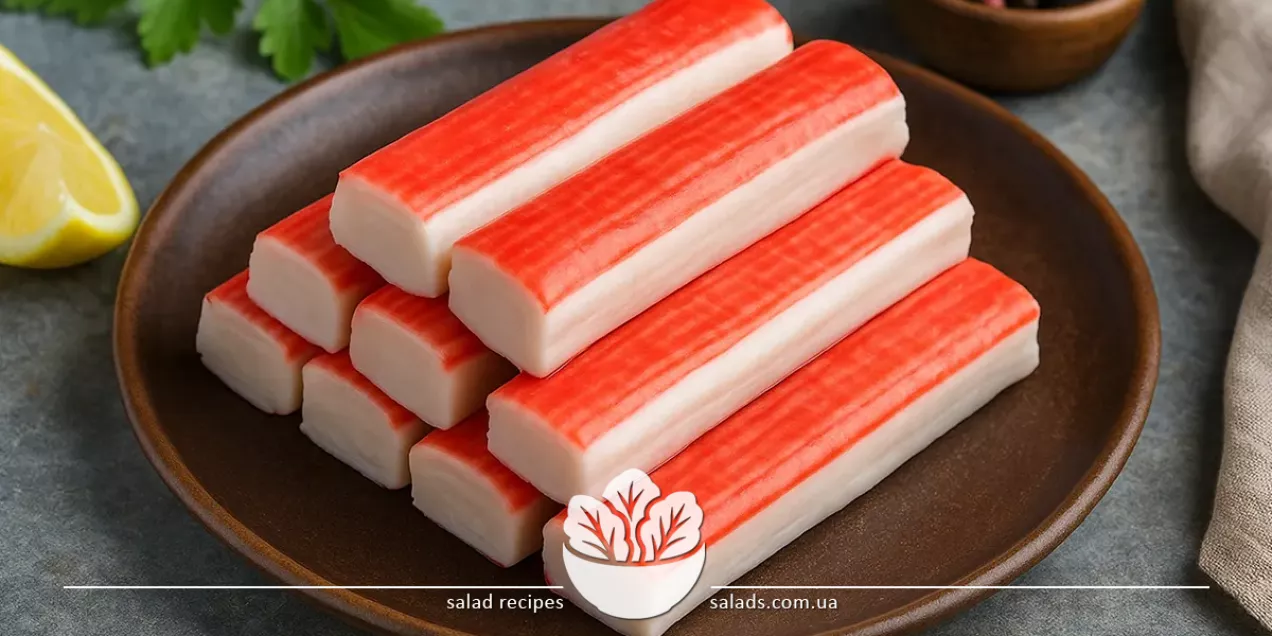
Crab Sticks

Crab sticks are a product made from processed fish paste that mimics the taste and texture of crab meat. They have a tender texture and pleasant, delicate flavor, making them popular in the preparation of salads, appetizers, and quick meals. Crab sticks are highly convenient due to their shape and ready-to-eat nature. For more information about seafood, visit the seafood section.
Salad Recipes with Crab Sticks
Classic Recipes with Crab Sticks
Crab sticks are one of the most popular ingredients for preparing salads and cold appetizers, appreciated in many world cuisines for their tender texture and delicate flavor. They pair perfectly with fresh cucumbers, which add freshness, lightness, and juiciness to the dish. Fresh lemon or lemon juice highlights the subtle flavors of crab sticks, adding brightness and a harmonious balance of acidity and sweetness. Adding canned beans to salads makes them more nutritious and satisfying. Using unrefined olive oil in dressings enhances the aroma of crab sticks and provides a soft fruity aftertaste that enriches the dish’s flavor profile. Such salads are perfect for both everyday meals and festive occasions. Crab sticks are also used in combination with other meats, particularly turkey, allowing for the creation of more complex and hearty dishes. Their ease of use and versatility make crab sticks a highly sought-after ingredient in both home cooking and professional gastronomy, where they appear in a wide range of seafood recipes.
The Role of Crab Sticks in Modern Cuisine
Crab sticks have long ceased to be just a budget substitute for real crab meat and have become a full-fledged ingredient with their own flavor profile. They are widely used in many modern cuisines around the world due to their convenient shape and lack of need for additional processing. This makes them ideal for quick meals where speed matters, but taste must not be sacrificed. The use of crab sticks goes beyond classic salads. They are added to sushi, rolls, casseroles, soups, and even hot skillet dishes. Their light saltiness and tender texture pair well with vegetables, rice, and sauces, allowing for diverse flavor combinations. A particularly popular combination is with avocado, cucumber, rice, and mayonnaise in Japanese cuisine. Crab sticks are also actively used in fusion cuisine, where traditional recipes meet modern techniques and unconventional ingredients. This results in unique dishes with an unforgettable flavor bouquet, easily prepared at home or served to guests on festive occasions. Thanks to their versatility, crab sticks are popular among both professionals and home cooks.
Choosing Quality Crab Sticks
When selecting crab sticks, it is important to pay attention to the product’s ingredients and manufacturer. Quality crab sticks are made from natural fish paste without excessive artificial additives or preservatives, preserving their delicate flavor and nutritional benefits. It is crucial that the composition does not include high amounts of starch, colorants, or flavor enhancers, as these can affect both taste and texture. The color of crab sticks should be uniform, without dark spots or an unpleasant sheen, and the texture should be firm and elastic. Check the production date and expiration date, as fresh sticks offer a more pronounced flavor and better consistency. When choosing crab sticks, it is best to opt for trusted brands and certified products to ensure safety and high quality. This guarantees a tasty and nutritious outcome in your dishes.
Preparing and Using Crab Sticks
Crab sticks are a very convenient ingredient that does not require additional heat treatment, making them indispensable for quick and light dishes. They are most often used in cold salads, where they are combined with vegetables, herbs, mayonnaise, and other sauces to create a tender and balanced taste. In addition to salads, crab sticks are used to prepare festive appetizers such as stuffed vegetables or rolls made from thinly sliced crab sticks. They are also added to rolls and sushi, serving as the main seafood component with a pleasant taste and texture.
Crab sticks are also found in hot dishes – they are added to soups, casseroles, and sometimes omelets. They maintain their shape well when heated while retaining tenderness, making them a quick and flavorful ingredient that complements seafood dishes. Crab sticks are also popular in vegetarian recipes as an alternative protein source, pairing well with various vegetables and grains. Their versatility makes them a staple in home kitchens and restaurants alike.
Storage Tips and Usage Recommendations
To preserve freshness and taste, crab sticks should be stored in the refrigerator at a temperature between 0 and +6 °C in airtight packaging. Once opened, they should be consumed within 2-3 days to avoid loss of flavor and bacterial growth. It is not recommended to store crab sticks at room temperature, as this can lead to rapid spoilage. For long-term storage, freezing is possible, although it may slightly alter their texture. Leftover crab sticks can be easily incorporated into other dishes such as salads, casseroles, soups, or hot appetizers. Proper use and storage help maintain the product’s nutritional value and flavor while minimizing food waste.